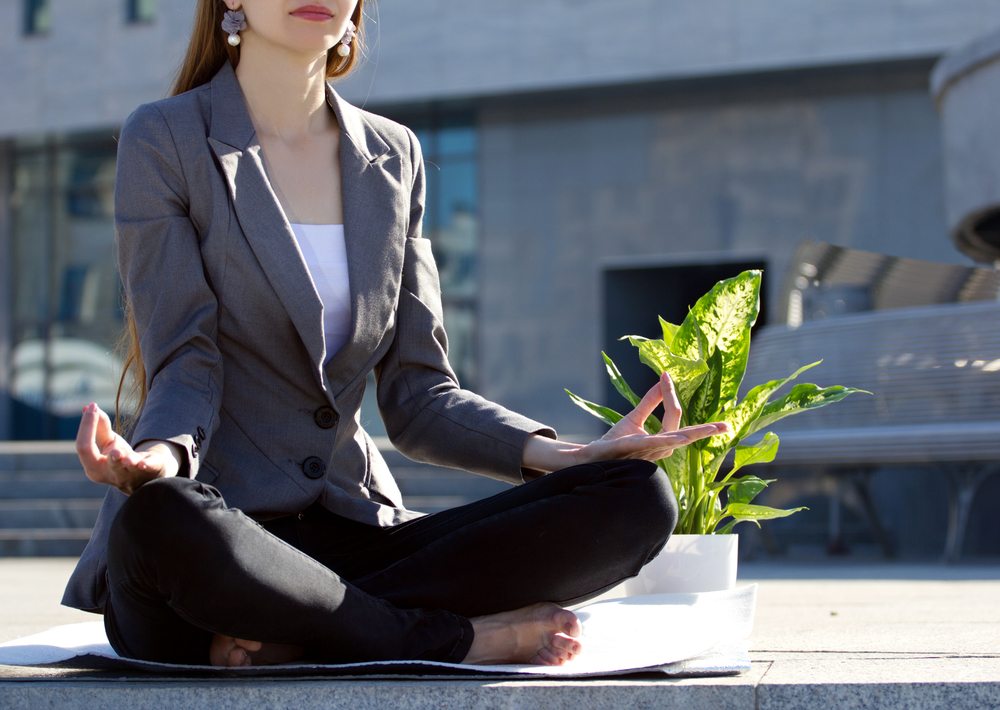February 2013, Washington, DC: My college friends C* and B* are visiting W* and me.
We’ve just gotten back from the bar and are sitting in a circle in our underwear (it’s not what you think, but don’t ask).
C* declares that it’s time to meditate. He picks up my metal water bottle and hits it with a stick while yelling, “GONGGGGG!” at the top of his lungs.
Once I stop laughing, I close my eyes and attempt to focus on my breath for 15 minutes. Halfway through, I notice that I feel really close to C* and B* (W* isn’t a meditator and excused himself at the beginning of the session).
At the end of the 15 minutes, W* sneaks up and shoots at us with a Nerf gun.
We all start laughing.
Later that night I shyly mention to C* and B* that I felt really close to them while we were meditating. I expected them to tease me, but instead, they said that they unexpectedly experienced the same closeness.
***
Over the past seven years I’ve spent about 30 minutes in meditation (nearly) every day. Some of the sessions lasted for several hours while others were literally one minute. I’ve studied with a wide variety of teachers from multiple lineages and spent, cumulatively, about two months in silent retreat.
My aim in this article is to help you understand meditation. We’ll cover how to do it, why it might be worth your time, why it may be a waste of your time, and how it’s changed my life. I’ll also share a list of resources for those looking to dive deeper into their practice.
Five ways meditation has improved my life

People often fail to distinguish their direct experience from the universal truth; they believe that since something is true to them, it must be true to everyone. In reality, direct experience and universal truth are two different animals. Everything in this section is true as it pertains to my experience with meditation. However, I make no claims about universal truths. I’m not sure that I – or any human – actually has the ability to access universal truth (if it even exists).
And I want to be clear about something else: meditation has affected me profoundly. It’s drawn me into the moment, made it easier for me to access my innate confidence, and fostered a deep sense of connection between the universe and myself. Still, I don’t always feel like that. I flick in and out of the moment, my confidence falters, and I feel isolated from time to time. What I have noticed though is that with each passing year, the benefits of meditation become more stable in my life.
With that in mind, here are the ways mediation has changed me personally. Your results may vary:
1: I’ve increased mastery over my thoughts and feelings. In Nov of 2014, I was scheduled to speak at a conference in Paraguay. I flew from Boston to Detroit and was supposed to fly from Detroit to Paraguay. When the gate agent in Detroit asked for my passport, I realized something dreadful: my passport was gone. I couldn’t board the flight to Paraguay.
The short version of the aftermath: I flew back to my nearest birth certificate in Boston, used my birth certificate to get an emergency replacement passport, and then explored every feasible option to get to Paraguay ASAP. In the end, my lost passport delayed the conference of over 500 people by an entire day.
Through the chaos, I was able to remain centered and focused. In fact, the people around me were shocked by my composure. While I didn’t like the situation, I also understood that getting upset would be counterproductive. This enabled me to channel all my energy into solving the problem at hand, rather than being eaten alive by it.
When you practice meditation (and I’ll explain how in a moment) you start to realize you are not your thoughts. The chaos inside your head? It’s not you. Don’t get me wrong – thoughts are deeply captivating. They can be empowering. They can change the world. They can wreck shit. But they aren’t you.
As your practice deepens, you’ll begin to notice something else: you aren’t your feelings either. In fact, thoughts and feelings work together to distract you from your true nature.
When you cut through the trance, you’ll notice that there is a source of consciousness and life deep within you. Though there are a wide variety of names (and often explanations) for this source, it’s usually referred to as one of the following: the soul, God, the Universe, genetics, epiphenomena, the true self, or the Source.
Realizing I am neither my thoughts nor my feelings allows me to intentionally shape my life. It allows me to control my actions (and on a good day, my reactions), while accepting the circumstances I’m dealt. This makes it easier for me to revel in the good times, keep my head above water during the bad times, and remain playful throughout.
2: I’ve found a deep sense of unity and connection between others, the world, and myself. At first glance, the human experience is characterized by isolation, separation, and disconnection. As far as I can tell, the sense of being separate from the world and its people is an illusion.
When you allow yourself to cut through the trance of thoughts and feelings, you’ll notice that the sense of separation from the world vanishes. In its place, you’ll find a deep sense of connection. I think it was this mutual connection that made C*, B*, and I feel close to one another when we were meditating together.
Once they know what to look for, most meditators will be able to feel some sort of connection to the Source. I’ve noticed that the more I stay true to myself, the more easily I can feel my connection to everything. Many meditators will feel the connection so deeply (if also fleetingly) that they end up believing the separation between life forms is nothing more than an illusion.

3: On a good day, I understand that the past and future are mental constructs and that I have everything I need in this exact moment. Anyone who has ever smoked a joint or taken a high school physics class has had some variation of the following conversation, “Dude. Time isn’t real. We just like, made it up, you know?”
And while it’s easy to say that nothing exists outside of this moment, truly embracing it is difficult.
The concept of time is built into how modern humans experience life. Divorcing your experience of this moment from the concept of time is challenging. It feels like dismantling the scaffolding you’re standing on. However, once you understand it, you gain an extreme measure of power over yourself, your experience, and your reality.
I’ll do my best to explain how to do this, but fair warning: words aren’t an ideal medium for understanding the dissolution of time.
First, notice that the past only exists as memories and concepts in your head. Yes, all your memories from the past really did happen (or most of them, at least), but they aren’t happening now.
If you’re experiencing emotion or fascination about something that happened in the past, you’re manufacturing that emotion in your head. There’s nothing wrong with manufacturing thoughts or feelings, but realize that when you do this, you’re living – quiet literally – in a fantasy.
Next, notice that the future is purely hypothetical. You can worry, plan for, and get excited about the future if you’d like, but don’t trick yourself into believing that the future you imagine holds any bearing in reality. Your future (like your past) exists purely in your head. It’s nothing more than a concept.
Finally, as you realize that the past and future are little more than mental constructs, you’ll realize something else: the present isn’t a mental construct. You realize that the present moment is filled with inexplicable potential.
You start to understand that the present moment is also the only permanent thing in your life. When you experienced things in the “past”, you didn’t say to yourself, “Wow, I’m in the past now” while you were experiencing them. You experienced them as the present. Similarly, when the “future” arrives, you won’t say to yourself, “Holy shit, I’m living in the future,” instead you’ll say to yourself, “This is what’s happening now.”
And that’s really cool, because when you realize that this moment is all you’ve ever had and all that you’ll ever have, you can begin to create anything you want and make up the rules along the way.
You may not be able to draw $1,000,000, the love of your life, and a tropical vacation into this exact moment, but you do have everything required to begin the process of finding and creating those things. When you start, you’ll notice that you can create your dreams more fluidly than you’ve been led to believe.
You’ll realize that by improving the quality of this moment, you will improve the quality of “future” moments. Your job is to avoid the trap of manufacturing artificial realities from the past or future and stay grounded in the only thing with true potential: this moment. When you do this you will access more potential than most people realize is possible. A stable meditation practice helps.
4: I’ve gained easy and fluid access to my own innate resilience, confidence, calm, and courage. After you understand that you can only ever experience life from the lens of the moment, you realize that you can handle anything thrown your way.
I don’t mean that life suddenly becomes unicorn shits and gumdrops. In fact, in some ways, quite the opposite is true. What happens is you become familiar enough with the world’s darkness to understand that it will pass. You become familiar enough with the world’s joy to fully revel in it when it appears. You become familiar enough with your own resilience and tenacity to realize you’re a warrior. You notice that even when you’re extremely anxious, afraid, or hopeless, you can handle it. You realize that when you improve this moment, even just a bit, the next one will be better.
A tangible example: a few weeks ago I wrote about a painful sequence of events in my life. I went through a breakup, I feared for the state of my country, and someone close to me was diagnosed with brain cancer. There were multiple times during that phase when I was driven to tears, yet I never lost myself; I knew that no matter how bad it got, the darkness would pass.
When you realize that you can handle anything life throws at you (and I promise, you can) it feels like you’ve been handed the ability to ever so slightly bend the world to your will.
5: The benefits virtually everyone experiences: increased happiness, increased resilience, decreased anxiety, and a renewed ability to focus. All of these benefits seem to be nearly universal – and often pronounced – among mediators. In fact, most of them are so immediate that I don’t want you to take my word for it. Instead, spend two minutes meditating every day for the next 10 days. See how it affects you. You may be surprised…
How to meditate

The first thing to understand about meditation is that it’s more difficult than it seems (kind of like running a marathon). If you find yourself struggling a bit, don’t worry. That struggle is – in essence – the point.
At its core, meditation is the practice of trying to fix your mind on a single point of focus.
I’ll walk you through a simple approach and explain which variations are worth exploring and how to make meditation a habit.
1) Sit in a chair with your feet flat on the ground and your spine straight. Place your hands in your lap, on your thighs, or on your knees. Your palms may be either face up or face down, depending on which is more comfortable for you. The goal is to position yourself so that you are both relaxed and alert.
2) Close your eyes.
3) Focus on your breath (to the best of your ability). You can do this by focusing on any of the following: your stomach or chest rising and falling, the feeling of your breath right below your nose, the breath moving in and out of your nose, or the sound of your breathing. Again, do whatever is easiest for you.
Do not force yourself to breathe, just notice what’s happening in your body.
I like to begin by counting my first ten breaths, because it helps me focus and relax. If you do this and lose track of what number you’re on, simply start again at one. Once you’ve reached ten, stop counting and focus purely on your breath.
4) You will notice that your mind drifts. While you’re trying to focus on your breath, you’ll start thinking about the day ahead, an embarrassing memory from sixth grade, your outfit for the Christmas party, food, money, gossip, sex, and a million other things.
When you notice your mind drifting, simply bring your attention back to your breath.
The process of attempting to focus your mind, noticing that your attention has drifted, and bringing it back, is the entire practice of meditation.
Many people believe that the goal of meditation is to empty your mind. That’s not possible. The goal is to concentrate on a single point of attention. Sometimes this will be easy. Sometimes it will be impossible. Both are fine. Your aim is to increase your comfort and presence in this moment. This is done by noticing when your attention has drifted and then bringing it back.
Modifications to your practice:
There are countless ways to modify your meditation practice. Experiment with the options below to see what works for you. Also, consider taking classes in different styles to find which is best for you.
Focal point: if focusing on your breath doesn’t work for you, consider focusing on a mantra, the flame of a candle, a flower, a chant, the ground in front of you, the sounds around you, or the weight/feeling of your body.
Posture: the most common form of meditation is seated, either on a chair or a cushion. If you’re sitting on a cushion, you may sit cross-legged, in half-lotus, or lotus. However, you don’t need to be sitting. You can meditate standing up, lying down, or while walking. If you’re meditating while walking your focal point should be a specific part of your stride. I focus on my heel and toes striking the ground.
Eyes: I keep my eyes closed, but it’s fine to keep your eyes open during meditation. If you do, just be sure to use a soft, gentle focus.
Fidgeting vs sitting still: most schools of thought suggest that you should sit perfectly still while you meditate (or at least attempt to). I can’t do this. If you need to fidget, stretch your legs, crack your knuckles, or even stand up, simply shift your attention from your normal focal point to the movement that you’re creating in your body.
How to make meditation a habit:
There are two approaches to creating a daily meditation practice.
The first is to dive in with a multi-day retreat led by a teacher. The idea is that you will have a powerful and direct experience with meditation and that you’ll see the benefits so quickly and so clearly that it becomes a permanent fixture in your life.
This strikes me as unrealistic. Few people are able – let alone willing – to invest multiple days into a skill they have minimal experience with. I wouldn’t.
The second approach, which I believe is superior, is to slowly develop the habit. As with any new behavior, it’s easiest to start small.
Begin by spending two minutes a day in seated meditation. Try to meditate at the same time each day. Once you’re comfortable with two minutes (and this could take weeks), try three. Then do four, and so on and so forth. Only add time to your practice when you really, really want to. Building your practice this way will integrate meditation into the flow of your life. If you miss a day or two, don’t worry about it.
The quiet risks of meditation

Like anything else, meditation is not without its risks. Unlike most things, people almost never talk about the downsides of meditation. These are the common pitfalls to look out for and a few guidelines to help you avoid them:
Using meditation as a tool to avoid reality. Many people who need to diet, talk to a psychologist, lean into hard conversations, or pull their lives together use meditation as an excuse not to do so. They tell themselves, “I just need to meditate more, and then everything will be ok.” Bull. Shit. This is nothing more than a thinly veiled form of fear and procrastination.
Meditation is a great tool for studying your mind and the moment, but it is not a panacea. If you find yourself using meditation to “prepare” for something in the future, you need to stop meditating and go fix the problem you’ve been avoiding.
A very simple rule of thumb: if you’re experiencing a problem in your life, assume that meditation cannot solve it. Address the problem directly.
For some people meditation is a massive waste of time: meditation is not for everyone. I have several friends who have tried meditation and gained nothing from it. I’ve met people who have dedicated huge chunks of their lives to meditation with little to show for it.
Many people fall into meditation in the same way that others fall into religion. They never ask themselves, “Do I enjoy this?”, “Do I believe in this” or “Does this provide benefits for me or the world?” Instead, they just go through the motions hoping for a miracle.
Here’s the rule: if it seems like it’s benefitting you, stick with it. If you’ve experimented with it for a bit and it feels like a waste of time, let it go.
The time you spend in “meditation” is actually time spent lost in thought: the vast majority of people who claim to be meditating, aren’t. What they’re really doing is thinking. They’ve become so captivated by their thoughts that they don’t even notice they’re thinking.
For almost everyone, the rule is simple: if you never noticed your thoughts during a meditation session, you weren’t meditating. You were literally lost in thought. This is the opposite of meditation. Meditation is the act of noticing your thoughts, letting them go, and returning to a single point of attention.
Expecting meditation to do something for you in the future. Meditation is entirely about the moment. If you’re meditating so that you may be different in some distant future, then don’t waste your time. Instead of trying to manipulate an imaginary future, improve this moment right here. Doing so will improve the next moment.
Claims about meditation that may or may not be BS

The more you study meditation, the more outlandish the claims of its power become. You’ll hear of yogis who can hold their breath underwater for days at a time, immortal beings walking among us, monks who can float, and genuine alchemists who can turn any metal into gold. To me, all of those claims seem like obvious bullshit.
However, there are a few claims that seem absurd at first glance, but may hold water. Two that I think may be possible, but I am yet to have direct experience with (and thus remain gently skeptical of): meditation will help you uncover latent psychic abilities and meditation will give you access to hidden dimensions of reality.
I’m open to these ideas because some of my teachers, mentors, and friends claim to have had direct experiences with psychic abilities and deeper dimensions of reality being uncovered through meditation. These people are not the new age weirdos you think they are. Several of them built multi-million dollar businesses and accumulated true influence in government and entertainment. Because of their grounding in reality, I can’t help but approach their claims with curiosity.
My recommendation to you is quite simple: stay open and judge for yourself. Trust your direct experience over the claims that others make.
Resources
If you’d like to deepen your practice or continue exploring meditation, here are a few resources:
“Peace is Every Step” by Thich Nhat Hanh -This is my favorite book on meditation. It’s short, readable, and clear. I particularly like the “Tangerine Meditation” and used to use it at my advanced leadership trainings.
What’s magic about Thich Nhat Hanh (often referred to as “Thay”) is that you can feel his calm presence in the words he writes. Others have found Thay’s book “The Miracle of Mindfulness” to be a great introduction to meditation. While I enjoyed Miracle, I thought Peace was stronger and more readable.
“Mindfulness in Plain English” by Bhante Gunaratana – If you’re looking for a clear, accessible approach to understanding mediation, this book is a great introduction. It’s fast, easy, and precise. I think Gunaratana is a bit stricter than necessary, and I find some of his claims dubious, but still, this is an excellent text.
“Waking Up” by Sam Harris – Unlike many authors who attempt to explain how meditation affects the brain, Harris is actually a neuroscientist. While I don’t agree with everything Harris writes, if you’re even passively interested in the intersection of meditation and neuroscience, this is the book for you.
Insight Meditation Timer – I’ve used this app daily for five years. It includes tracking which is a great feature for people starting out. What I particularly love is that it works in airplane mode so you can effectively disable your phone’s ability to distract you while you’re meditating. Many of my friends use Calm or Headspace. I have no direct experience with these apps, but have heard good things.
Meditation groups and classes – most cities and many towns have meditation classes. I like the Insight Meditation Community and have attended their classes in Washington, DC and Denver, CO. Transcendental Meditation, commonly referred to TM, is also extremely popular, but the price point makes it prohibitive for many people (which makes me question their motives). Many yoga studios also offer meditation classes. Shop around until you find the one that’s right for you. Just keep in mind that many meditation teachers don’t actually understand what they’re attempting to teach, so if you get a weird vibe, keep searching.
Years ago I tried the approach of intensive meditation retreats. The first one was kind of disastrous in that I was miserable. The second, maybe 8 years after the first (both were ten day retreats), it became about getting high, which seemed somewhat of a trap, although a nice one. In fact, at the end of that retreat (no walking in that one) I developed a pinched sciatic nerve and had to be carried into the meditation hall. I thought it would jump-start a daily practice, but I was never able to do that, although I do meditate on occasion and I experience an open heart. Now having the same experience as you did, having several hints in the last number of days that it is time to start again. I am in that retreat stage of life that Hindus see as the time to go inward. Thanks for the wisdom!
Whoa. That’s really cool that this article felt like a hint to return to your meditation practice. I’ve been toying with a ten day retreat myself, specifically the Vipassana one which a lot of my friends have loved, but it seems almost too much for me. A day or two of silence and I get flooded with kinetic energy. I can’t imagine needing to wrestle with that while also sitting perfectly still. Woof. I think you’re right (and the Hindus): there’s probably a phase of life when it makes sense to run around the external world, and a phase of life when it makes sense to go inward. I think we cycle in and out of those.
Hi there
Thanks so much for this.
This bit ,The process of attempting to focus your mind, noticing that your attention has drifted, and bringing it back, is the entire practice of meditation.’ Is soooo helpful. I thought I was going wrong as I couldn’t empty my mind and was getting frustrated so knowing what meditation is, really helps me.
Also the mindfulness, in the moment stuff, is so well explained here that it actually feels achievable and innately right.
So, thank you for this. It’s really really helpful to me.
I will carry on, knowing that I am doing it right.
By the way, can I ask, why, when I try this does my mind always wonder off to negative and not nice images or thoughts… that jolt me somewhat, out of the moment.? I know the idea is to learn to obeserve all thoughts and that they are not me, but they feel so real and upsetting that I am unnerved by them.
Many thanks again,
Hey Nina – so glad to hear the article was helpful. 🙂 And don’t worry – it sounds like you’re doing it exactly right. Good job!
As for why your mind drifts to the negative. Here’s my personal theory: I think your mind is showing you something you need to deal with. It could simply be that you’ve let more negativity into your life than you meant to (which happens to pretty much everyone at one point or another). It could also be something a bit more complicated, like an old wound that you need to pay attention to. Regardless, don’t worry too much about it, even if it jolts you out of the moment. Just try to observe your thoughts and when you notice that your mind is wandering (or that you’ve been jolted out of meditation) bring it back to your breath.